
|   |

|   |
Elevating interpretations of Marathi abhangs & Shankaracharya's Ashtakams - Vijay Shanker e-mail: vijaydance@gmail.com July 17, 2023 Marathi Sahitya Mandir (Vashi, Navi Mumbai) presented Keertan Rang, incorporating Marathi abhangs that portray devotional fervour and guides devotees to follow the Bhakti Margam for spiritual upliftment and enlightenment towards godliness, performed with complete involvement and devotion by Bharatanatyam dancer Apeksha Niranjan. Apeksha interpreted nine abhangs by saint poets like Gyaneshwar, Namdeo, Eknath and Ramdas that resonated well with the audience as they could relate to the compositions due to its closeness to life, wellbeing and divinity. The programme was held on 24th June at the auditorium of Marathi Sahitya Mandir. 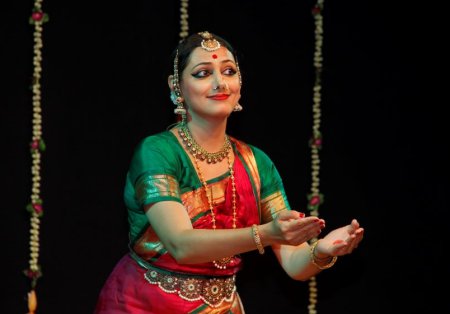 Apeksha Niranjan Apeksha, disciple of Guru Sucheta Chapekar, commenced the performance with the traditional Alarippu, interwoven with chants by saint Gyaneshwar in praise of Ganapati, Saraswati and the Omkara, making a fine start to the performance and journey incorporating devotional renderings that propagate the philosophy of righteousness, Karma and Dharma to be followed by everyone, irrespective of any caste or creed. In the second composition by Namdeo, the domestic help Janabai surrenders herself completely to the lotus feet of the Lord and tells him, "O Vitthala, You are my mother, my father, my brother, my sister, my friend," hence involves the lord in all the household activities and treats him as a human being. This number was well enacted with household chores, taking one closer to lokadharmi and the audience as well. In the composition by saint Tukaram, he imagines himself to be a Gopi who is mesmerized by the beauty and magical flute of Krishna. It is not easy for him to reach out to Krishna, as he is surrounded by other Gopis. Krishna is described as "Rajasa Sukumara." In the number by Eknath, "Bari Nave Tithatu," the saint poet advises his devotees to be truthful and follow the path of righteousness and narrates varied instances of cheating and lying, like Brahma trying to cheat Shiva by telling him that he found the peak of 'Agnilinga', Duryodhana teasing Draupadi and being defeated by Bheema and ultimately Ravana abducting Sita. In Gyaneshwar's composition "Tujiya Nidhale Koti Chandra Prakash" the radiance of little Krishna is compared to the radiance of several moons and the eyes like the lotus. This number also establishes the vatsalya between mother Yasoda and the naughty little Krishna. Saraswati Stavan in praise of the goddess by Swami Ramdas was an unusual experience due to the intense devotional vocal rendering by Aruna Sairam. This number also featured the Gondhal Bhavani as worshipped by the people. Apeksha dances with a natural quality of divinity which is a pleasure to behold. In the number by saint Goraknath, he says, "I do not need to take bath in the holy river as my guru's blessings is enough to wash away all the sins," establishing the unique Guru-shishya relationship. The concluding number, the Thillana in raag Madhuvanti was based on the composition by saint Narhari Sonar who was a professional goldsmith who says, "I am your goldsmith and taking your name is my earning." The finale number was the popular composition Tirth Vitthala by Namdeo which was danced with devotional intensity, winning her a standing ovation by the select audience. The most striking aspect of Apeksha's dancing is her natural flair and involvement with no artificial frills, trying to reach out to the supreme with devotion and sincerity. Powerful display of Shankaracharya's Ashtakams Nalanda Nritya Kala Mahavidyalaya and Dr. Usha RK, former cultural director, Embassy of India, Moscow, presented a unique Bharatanatyam presentation based on the 8 stanza compositions of the venerated Adi Shankaracharya Bhagvatpada by six accomplished dancers, Vaidehi Rele-Lal, Arundhati Patwardhan, Mithun Shyam, Anand Satchidanandan, Prachi Save Saathi and Keerthana Ravi at Nalanda's Kanak Sabha auditorium on 30th June, incorporating powerful display of stylized movements, captivating expressions, reaching out to the Supreme through Shankaracharya's philosophy of Advaita (non-duality). Shankara has left behind a treasure of exquisite gems in the form of sastras and stotras that has mesmerised the Indian philosophers of highest scholarship, the mystical spiritual seekers, the followers of Hindu religion and the ardent Siva Bhaktas. It is remarkable indeed, comparatively within a short life span of 32 years, he was able to write 113 books of high standard and merit. To his credit are 18 Bhasyas, the major ones being the Brahma Sutra, Upanishad Bhasya and Shrimad Bhagavad Gita Bhasya. He has composed 55 hymns of exceptional beauty of varied aspects of Nirguna (formless) and Saguna Brahman. The hymns range from eight verses to a hundred verses. Among his most popular works are the exquisite hymns that extol the beauty and glory of Devi in 'Soundarya Lahiri' and the greatness of Siva in 'Sivananda Lahari'. In Shankara's advaita or non-dualist vedanta, the Brahman is truth, Brahman is formless, Absolute Soul; the world, as is seen, is motivated on rotation of cycles of birth and deaths, appearances and disappearances. All entities from the stone to the stars including the living beings from the worm to highly evolved beings are all governed by these laws. Some regard the Ultimate Reality as personal and others as impersonal by shedding illusions based on several paths of action, knowledge and devotion, trodden through many lives and forms of life. It was exciting to watch the dancers incorporating varied aspects of the philosophy through different verses from the Ashtakams, commencing with the divine mother and goddess Sringeri Sharadamba and concluding with the Guru Ashtakam. The performance commenced with the exquisite verses in praise of the goddess of learning and knowledge, Sringeri Sharadamba, performed by Vaidehi Rele with finesse and poise. Vaidehi looked resplendent with the power and glory of the goddess sung with devotional fervour by the vocalist Vidya Harikrishna, as she blossomed from the lotus to dispel ignorance with gnana and bless her devotees with peace and prosperity. Vaidehi made a fine start to the performance with subtle and striking expressions and pleasing movements. 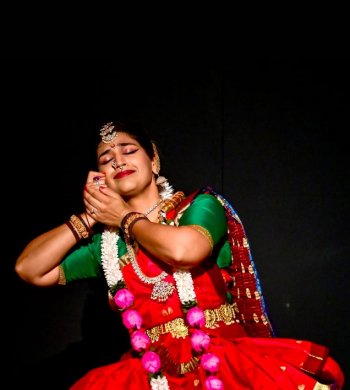 Vaidehi Rele 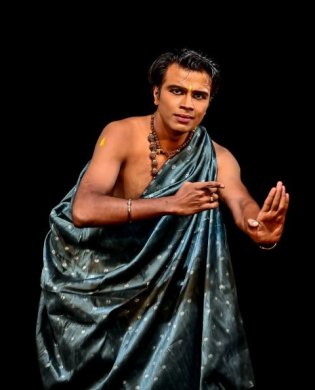 Anand Satchidanandan Anand Satchidanandan, disciple of the Dhananjayans, portrayed Lord Shiva as Dakshinamurti, the only image that is installed facing the south, hence the name Dakshinamurti, the 'gnana murti' of Siva; he is the great Guru and bestower of gnana or spiritual knowledge or wisdom to his devotees. Siva is depicted as a Yogi here, in full control of the self, with mind steady and absolute tranquillity. Anand's presentation was engrossing, attracting applause from the audience. Pertaining to Varkari Sampradaya (tradition of Varkaris), devotees go on pilgrimage to seek blessings of Lord Vitthala in Pandarpur, as they sing and dance his glory with complete surrender to the lotus feet of the Almighty; this is the Panduranga Ashtakam wherein the devotees reach a high state of consciousness. Danced extremely well with typical movements of folkish touch, it was a pleasure to watch Arundhati Patwardhan dancing with effortless ease and involvement. Arundhati is the daughter and disciple of Guru Sucheta Chapekar. 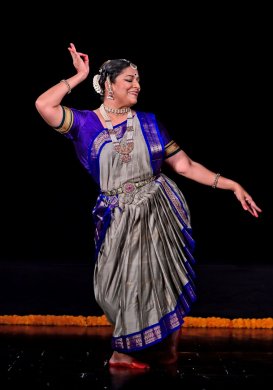 Arundhati Patwardhan 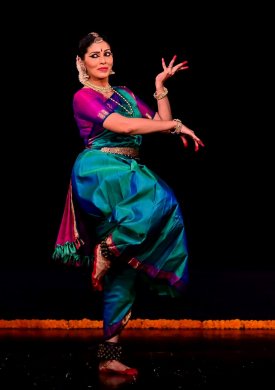 Prachi Save Saathi After the tapasya of sage Bageerath, the holy Ganga arrives from heaven to earth to wash away all the sins of the people, thereby making them blessed, peaceful and prosperous. Lord Shiva controls the Ganga and holds her in his jata. This scene of avartanam of the Ganga was immaculately performed by Prachi Save Saathi from Mumbai, a disciple of Guru Lata Raman. The Kalabhairava Ashtakam was performed by Mithun Shyam, leading dancer from Bangalore. Mithun with his vibrant and vivacious movements created a lasting impression portraying the Lord who controls time, life and death. The teenager Markandeya is an ardent devotee of Lord Shiva and worships the Shiva linga. The god of death Yama intervenes to take him away, as Markandeya prays to Lord Shiva and the Lord makes an appearance, saving Markandeya from the clutches of death. It is believed Lord Shiva as Kalabhairava is worshipped by anybody in distress and calamity, thereby restoring to the devotees his divine blessings and protection.  Mithun Shyam  Keerthana Ravi The last performer of the evening was Keerthana Ravi who is a fine performer. Keerthana beautifully interpreted the significance of the Guru Ashtakam (Tat Kim - So What). It does not matter if you are rich, with a big house or a beautiful wife; what matters is your control over your mind and blessings of the Guru which cannot be purchased, but has to be achieved with sheer devotion. Brilliant compering by Usha RK made the entire experience enlightening. The dancers received fine orchestral support from Vidya Harikrishna on vocals, Kalishwaran Pillai on nattuvangam, Dakshinamurthy on mridangam, Mangala Vaidyanathan on violin and the veena played by Saraswati.  Vijay Shankar is a Kuchipudi and Kathakali exponent, teacher, bilingual journalist, arts critic and actor. |